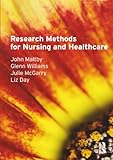Research methods for nurses / John Maltby ... [et al.].
Material type: TextPublication details: Harlow : Pearson Education, 2010.Description: 416 p. ; 24 cmISBN:
TextPublication details: Harlow : Pearson Education, 2010.Description: 416 p. ; 24 cmISBN: - 9780273718505 (pbk.) :
- 0273718509 (Paper)
- 610.73072 MAL
- RT81.5
| Item type | Current library | Call number | Copy number | Status | Date due | Barcode | |
|---|---|---|---|---|---|---|---|
| Long Loan | TUS: Midlands, Main Library Athlone Nursing Collection | 610.73072 MAL (Browse shelf(Opens below)) | 1 | Available | 00212794 | ||
| Long Loan | TUS: Midlands, Main Library Athlone Nursing Collection | 610.73072 MAL (Browse shelf(Opens below)) | 1 | Available | 00212793 |
Includes bibliographical references and index.
1. An introduction to research methods:- Key themes--Learning outcomes--Introduction--The research process--variables--Looking more closely at aspects of the research process--The research process, theory and research: quantitative and qualitative aspects; analysing variables - the basis of the book--Evidence-based practice--Self-assessment exercise-Summary --2. Quantitative methodologies and research designs:-Introduction--Quantitative methodology--Quantitative research designs--Experimental design: clinical trials and randomised controlled trials--Quasi-experimental research designs: case-control and cohort research designs--Survey designs: cross-sectional and longitudinal--Self-assessment exercise--Summary --3. Qualitative research methodologies and methods:- Key themes--Introduction--Qualitative methodology and research designs--Qualitative methodologies--Qualitative research methods--Self-assessment exercise--Summary--4. Reading the literature and generating research ideas:--Introduction--Starting out--Search strategy--Generating research ideas--Self-assessment exercise--Summary -- 5. Setting up your study : methods in data collection :--Introduction--Choice of method--Experimental methods--Questionnaires and survey research--Interviews--Final important considerations in your study--Piloting your study--Self-assessment exercise--Summary--6. Qualitative analysis : a step-by-step guide:-Introduction--Aims of qualitative analysis--The value of a competent qualitative analysis--Qualitative analysis of uniqueness versus commonalities--Different types of raw data in qualitative studies--Qualitative data handling decisions--The three stages of qualitative data analysis--Qualitative data analyses in action--Seven steps to a successful qualitative analysis--Self-assessment exercise--Summary -- 7. Blending qualitative and quantitative methods :Action research:--Introduction--Identifying the problem: the tensions between theory and practice--What is action research and what does it involve?--Self-assessment exercise--Additional self-assessment exercises--Summary --8. Quantitative analysis : using descriptive statistics:--Introduction--Practice in performing descriptive statistical analysis--Variables--Descriptive statistics: describing variables--Charts: visual presentation of variability with box plots--Beware of unusual data: outliers--Self-assessment exercise--Summary --9. Interpreting inferential statistics in quantitative research:--Introduction--Distributions--Probability--Significance testing--Inferential statistical tests--Statistical tests and the decision-making table--Making sense of inferential statistics: chi-square--Pearson and Spearman correlation statistics--Comparing average scores: statistics for all sorts of groups and occasions--Self-assessment exercise--Summary -- 10. Critical appraisal of quantitative and qualitative research:-Why should you use critical appraisal?--How do you do critical appraisal?--Top ten issues to consider with quantitative studies using an intervention--Top ten issues to consider with quantitative studies using correlational data--Critical appraisal of qualitative studies--Self-assessment exercise--Summary --11. Presenting your work to others:- Introduction--Writing a quantitative or qualitative research report--Presenting your research as an oral presentation-- Presenting your research in a poster--Self-assessment exercise--Summary --12. Advanced thinking in research methods and practice : from novice to expert nurse researcher:- Bridging the qualitative/quantitative divide--Mixed methods in nursing research--Triangulation and complementary approaches to understanding the area being researched--Collaborating with others--What is reflexivity?--Applying your research findings to nursing practice--Self-assessment exercise--Summary --13. Going forward : a step-by-step guide from research idea to ethics application:- Introduction--Defining your research question or area of enquiry--Conducting a search of the literature and reviewing the evidence--Identifying potential stakeholders and collaborators and others who will need to be involved in the development of your research --Developing your research proposal--Ethical considerations--Self-assessment exercise--Summary--Final comments: taking those first steps to becoming an independent nurse researcher.
This title is an introductory text for all nursing and healthcare students coming to research methods for the first time. The book includes coverage of the main research methods topics and provides guidance on how to understand and apply research techniques.
